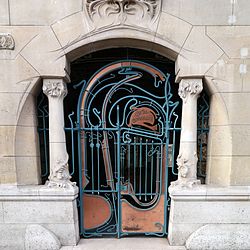Gate
This article includes a list of references, related reading or external links, but its sources remain unclear because it lacks inline citations. (September 2018) |
A gate or gateway is a point of entry to or from a space enclosed by walls. The word derived from old Norse "gat"[1] meaning road or path; But other terms include yett and port. The concept originally referred to the gap or hole in the wall or fence, rather than a barrier which closed it. Gates may prevent or control the entry or exit of individuals, or they may be merely decorative. The moving part or parts of a gateway may be considered "doors", as they are fixed at one side whilst opening and closing like one.[2]

A gate may have a latch that can be raised and lowered to both open a gate or prevent it from swinging.[3] Locks are also used on gates to increase the security. Larger gates can be used for a whole building, such as a castle or fortified town. Actual doors can also be considered gates when they are used to block entry as prevalent within a gatehouse. Today, many gate doors are opened by an automated gate operator.
Purpose-specific types of gateEdit
- Baby gate a safety gate to protect babies and toddlers
- City gate of a walled city
- Hampshire gate (a.k.a. New Zealand gate, wire gate, etc.)
- Kissing gate on footpaths
- Lychgate with a roof
- Mon Japanese: gate. The religious torii compares to the Chinese pailou (paifang), Indian torana, Indonesian Paduraksa and Korean hongsalmun. Mon are widespread, in Japanese gardens.
- Portcullis of a castle
- Race gates a gate used checkpoints on race tracks.
- Slip gate on footpaths
- Turnstile
- Watergate of a castle by navigable water
- Slalom skiing gates
Image galleryEdit
This gate and massive gateposts has no locks—a gate marks a borderline in ownership/use and can allow passage.
Ishtar Gate is the oldest city gate in existence
Wringin Lawang, a 14th-century Majapahit split gate, called "Candi bentar", in Trowulan, Java, Indonesia
This gate at Columbia University was closed to prevent entry of protesters
The gate of Finlayson factory in Tampere, Finland
A gate at Kansai University, built in 1923
Malaysian King's Palace Gate, Kuala Lampur
Medieval ironclad city gate, from the Upper Gate in the old town of Ohrid
Chinese traditional type gate (iron gate in front of house) in Kerala, India
Gates decorate routes in the entrance of Muscat, Oman
Kuwait Gate, historically surrounded Kuwait City, built in 1929
Royal Military College of Canada front gates and gatehouse
Decorative emblems of state are also fixed on gates to public buildings, old Royal Melbourne Mint
Gate of Shri Swaminarayan Mandir, Bhavnagar, India
Dr.Babasaheb Ambedkar Marathwada University gate on the eve of Namvistar Din celebrations reflects Ajanata art
Michael's Gate in Bratislava, Slovakia
St. Louis Gateway Arch
Warsaw University main gate, Poland
Gate of Farm Gunsteling in Namibia (2017)
Thai Temple (wat) gate at Wat Suan Dok, Chiang Mai
A gopuram, Hindu temple gate tower, in Sri Lanka
A Japanese temple gate (mon) at Eiheiji
A Moorish architecture gate in Alhambra, Granada, Spain
See alsoEdit
- Barrier
- Boom barrier (a.k.a. boom gate)
- Border
- Gate tower
- Gopuram
- Leave the gate as you found it
- Portal (architecture)
- Portcullis
- Threshold (disambiguation)
- Triumphal arch
- List of scandals with "-gate" suffix
- Watergate, as used in politics
ReferencesEdit
- ↑ "gate | Origin and meaning of gate by Online Etymology Dictionary". www.etymonline.com. Retrieved 2019-04-20.
- ↑ "GATE | meaning in the Cambridge English Dictionary". dictionary.cambridge.org. Retrieved 2019-04-20.
- ↑ "Hardware 101: Gate Latches". Gardenista. 2016-11-17. Retrieved 2019-04-20.

